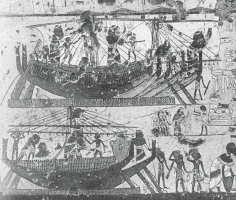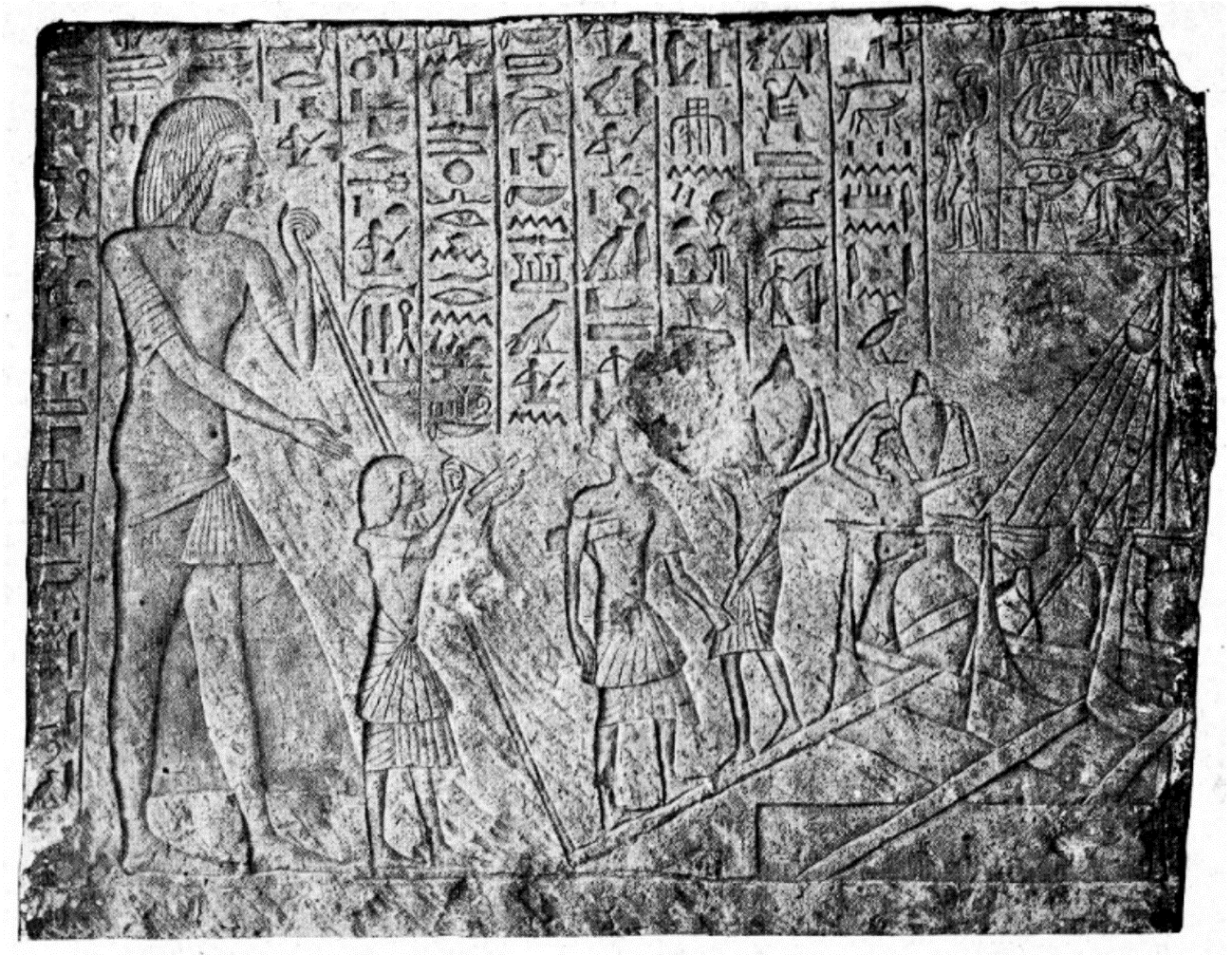Crescentic hull with a strong sheer. The stempost is vertical and straight, tapering into a pointed extremity that lacks decoration. There is a screen above the sheer represented by two oblique parallel lines that follow the same angle as the hull. The left ship has a hogging truss that crosses in front of the pithos and rises aft at an angle. The mast is slender, with the boom at the level of the stempost’s extremity, supported by six lifts. A basket-like crow’s nest hangs from the forward side of the mast. Peeking out of it is the torso of a tiny figure with an extended arm.
Merchant Syro-Canaanite ships
L4
19th-20th Dynasty (c. 13th century B.C.)
Iniwia tomb
Stone relief
Cairo Museum EM 11935
Emanuel 2014: 30; 2015: 169; Knapp 2019: 129, fig. 30; Landström 1970: 138, fig. 403; Wachsmann 1987: 10-11, pl. IV:A, VI: A; 1998: 54-60, figs. 3.24, 3.30, 3.31; 2019: 50-53, figs. 44, 51a, 53
Objects, human figures and sometimes entire scenes were occasionally composed by Egyptian artists by uniting elements from two or more distinct sources, resulting in non-existent "hybrid" items. Wachsmann provides several examples of this practice and argues that the ships of the Iniwia tomb are a product of such hybridization, using elements from Hatshepsut's Punt ships from Deir el Bahari on the one hand, and Syro-Canaanite vessels such as those depicted in the Kenamun tomb on the other. The Syro-Canaanite elements include the general layout of the scene, the nature of the cargo, and certain details of the ships' construction. To the right appear three ships docked at an Egyptian port, of which only the bows survive. Each has a boarding ladder and a large pithos stowed at the bow. Two porters facing left are shown carrying Canaanite jars on their shoulders. One of them is still aboard the left ship, while the other is shown descending down the boarding ladder. He is met by an Egyptian official in the process of climbing up the ladder, holding a staff in his left hand and a pen box under his right arm. Behind him is a scribe with raised arms, writing with a stylus.
Wachsmann has argued that due to the hybridity of the vessels, these cannot be used to reconstruct an actual ship. The bow compartment has been likened to the Punt ships, while the hogging truss is a distinctive feature of Egyptian seagoing vessels. Other elements however belong to the Syro-Canaanite tradition, notably the screens above the sheer, and crow's nest which appears exclusively on Syro-Canaanite ships prior to the 12th century. This is also supported by further details in the composition and their remarkable similarity to the Kenamun ships, including the pithoi stored at the bow, the cargo of Canaanite jars, and the two Egyptian officials. The latter are identical in the two compositions except for their clothing and the fact that the pen box was transferred to the figure with the staff in the Iniwia scene due to the scribe's raised arms.
Emanuel, J.P. 2014. “Sea Peoples, Egypt, and the Aegean: Transference of Maritime Technology in the Late Bronze Age-Early Iron Transition (LH IIIB-C),” Aegean Studies 1.1: 21-56.
―――. 2015. “Sailing from Periphery to Core in the Late Bronze Age Eastern Mediterranean,” in J. Mynářová, P. Onderka and P. Pavúk (eds.) There and Back Again – The Crossroads II: Relations between Egypt, the Aegean, the Levant, and the Sudan in the 2nd and 1st Millennia B.C.E. Prague: Charles University Faculty of Arts, pp. 163–180.
Knapp, A. B. 2018. Seafaring and Seafarers in the Bronze Age Eastern Mediterranean. Leiden: Sidestone Press.
Landström, B. 1970. Ships of the Pharaohs: 4000 Years of Egyptian Shipbuilding. Garden City: Doubleday.
Wachsmann, S. 1987. Aegeans in the Theban Tombs. Orientalia Lovaniensia Analecta 20. Leuven: Peeters Publishers.
―――. 1998. Seagoing Ships & Seamanship in the Bronze Age Levant. College Station, TX: Texas A&M University Press.
―――. 2019. “On the interpretation of Watercraft in ancient Art,” Arts 8.165: 1-67.






